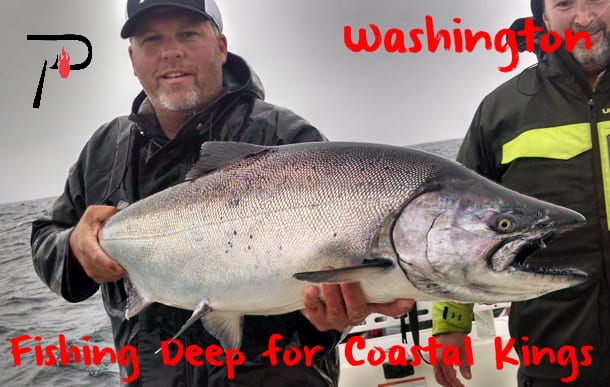Salmon
Fishing Deep For Washington Coast Kings
By: Sean Orr
Thirty years ago before hi tech downriggers, braided line and other essentials for deep water trolling were designed Washington’s coast was vastly unexplored for Chinook salmon by the private angler. Meanwhile, in the last 20 years these depths have been exposed and what we have uncovered is fascinating. We all knew Chinook like to be deep. In fact, they’ll swim 200, 300 and even 400 feet down. I’ve even caught a number of them 550 feet down while halibut and lingcod fishing.
Every year there is a deep water highway along our coast. Chinook migrate down the BC Coast and make their first big stop in Washington along the canyons off Neah Bay and La Push. These deep water canyons are like going to the biggest all you can eat buffet in the world. On any given day I have found herring, pilchards, anchovies, sardines, shrimp, squid and crab larva in their bellies. Many times, some of each. One day last week I found roughly 3-5 herring in each Chinook. The next day, in relatively the same area, they had 10-12 large anchovies in their bellies.

After few days of feeding these fish continue their migration. Some go into the Strait of Juan de Fuca on their way to Puget Sound and Canada and some on down the Washington Coast. Each day this area has fish entering and fish leaving. The pattern constantly changes. One day you can’t get your lines down without getting bit and the next you have to work all day to get a limit and you think they’re gone. The next day the area is full of salmon again and they are a completely different group if fish, identified by size, shape, color, etc.

In June and July these Chinook are voracious feeders. They eat most anything. Artificial lures work great.
Meanwhile, as they move down the coast and we get into August things change. A large portion of the Columbia River fish stay deep along the 280-400 foot depth line as they work their way down the coast until they turn and bolt into the Columbia River. Over the last 10 years I have moved with these fish all the way down. Once they hit just south of Leadbetter Point off Willapa they bolt for the Columbia River.
While you can catch fish on lures all the time herring begin to work much better than artificial as August wears on. Tides also become more important. The bite is more around the swings and the slow downs. Having fresh bait down deep at the right time of the tides can be the difference between one or two and a limit.

Every year we look for new ways to present offerings to entice these great fish and each year we get better at it. Technology is better, downriggers are better, our lines are better, our reels are better, longer rods, etc. It’s relatively easy to drop a hoochie, spoon, fly or plug to these depths, but getting a nice natural herring down to that depth, keeping it working right and having confidence it will stay on your hooks takes some skill. You have to rig a herring to stay on and swim correctly.

If you’re fishing Washington’s north coast we bait guys have to rely on good frozen bait and a great brine and rigging system. Our bite is largely a bait bite right now. Fire Brine helps cure a bait the proper way so we can get it down to these deep water feeders. While there’s a variety of vibrant color options I tend to stick with the Natural while fishing the ocean and sometimes add some blue to make the scales shine better. Having a good brined bait on the Washington Coast is the key to success right now. We’ve been catching nice Chinook on brined baits for a few weeks now.
How I Brine
I get the best frozen bait I can. Then I unthaw it halfway before adding Fire Brine. Allowing it to unthaw only half way helps to keep the scales in place while the brine works its magic.
Personally, I use two small coolers that are packed in ice inside of a larger cooler. This helps me maintain constant brine temperature everyday. I add Fire Brine to the coolers and 2-3 dozen baits per cooler. It’s important to let the sit in the brine for at least four hours before use, although sometimes an hour or two is enough.

If I am fishing several days in a row I add herring and brine each day to one of the coolers so I can keep a good supply of good bait going in the brines. It’s a hard balance to maintain a good bait supply, yet not to waste too much. Herring is expensive. We must minimize our losses.
Rigging it is an art. I always use a whole herring. You can go old school whole and do half hitches around the head and put a kink in it so it swims or you can go with a helmet of some sorts. I typically use a helmet for ease and it takes less time when I am trying to run several lines. I like to run them behind a flasher to get them to move. The flasher puts out vibrations and flash that Chinook hone it on.

Editor’s Note: Sean Orr operates Washington West Fishing Adventures. For more info on his Washington ocean salmon trips please visit http://www.washingtonwestfishing.com.






